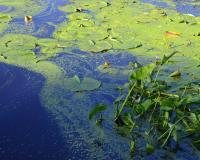
Vibrant Environment
Pollution Control
All | Biodiversity | Climate Change and Sustainability | Environmental Justice | Governance and Rule of Law | Land Use and Natural Resources | Oceans and Coasts | Pollution Control

On April 12, 2019, the U.S. Court of Appeals for the Fifth Circuit vacated portions of the U.S. Environmental Protection Agency’s (EPA’s) 2015 Effluent Limitation Guidelines (ELGs) and Standards for the Steam Electric Power Generating Point Source Category (ELG Rule). ELGs are nationwide standards set by EPA to govern pollutant discharges from point sources.

The famous Cuyahoga River fire of June 22, 1969 — the spur that started debate on pollution across the nation, and led to passage of the Clean Water Act three years later — is lodged more in legendary storytelling than in reality. The fire was actually fairly minor, causing only $50,000 in losses to the Republic Steel Mill located along the river, damaging some wooden trestles. Moreover, no photograph of the event exists — the photo reproduced here, like the one a month later in Time magazine, was from a much larger 1952 blaze.

PFAS is a catch-all term for the chemical compounds per- and polyfluoroalkyls (including PFOA, PFOS, and replacements such as GenX). Seemingly overnight, these substances have gone from something talked about mainly by environmental lawyers and advocates to something that the public is increasingly focused on. The reasons for this shift include EPA’s and the states’ move to regulate these substances, recent lawsuits targeting PFAS manufacturers, and a better understanding of the way these substances may persist in the environment and harm human health. Because the future costs and obligations regarding the cleanup of, and human exposure to, PFAS are uncertain and likely significant, they present a challenge for environmental attorneys and their clients when performing deal diligence and negotiating contracts.

The world is waking up to the growing problem of plastic waste contaminating our ocean and terrestrial environments. Local governments—lauded as laboratories of innovation—have begun enacting bans and fees on single-use plastics, reducing the amount entering the waste stream in the first place. Businesses are stepping up; national and multinational governance bodies are adopting laws cutting down on the manufacture and distribution of single-use plastics. In the United States, California, the District of Columbia, Hawaii, and Maine have initiated statewide restrictions, while Oregon and Washington are considering similar measures.

Lack of access to safe wastewater management infrastructure and improved sanitation is a global challenge that affects over 2 billion people worldwide. While large-scale wastewater treatment plants are common throughout the world, off-grid communities that exist outside of areas covered by centralized water infrastructure are often geographically isolated or economically marginalized, making these services not only unaffordable but inaccessible. In the absence of these networks, many communities have chosen to adapt. Although it is typically considered to be unlawful or illegitimate by their national governments, communities have begun to build decentralized systems to treat and reuse wastewater for agricultural purposes.

March 16, 2019; a young whale is found washed up on a beach in the Philippines. Autopsy reveals the whale died from “gastric shock” after ingesting 40kg of plastic rubbish including plastic bags and other disposable plastic products. Three weeks later, a pregnant sperm whale is found dead on a beach in Sardinia, Italy, more than two-thirds of her stomach filled with plastic waste.
These whales are the latest casualties of a growing worldwide plastic pollution problem.

Widespread harmful algae bloom (HAB) outbreaks have profound negative impacts: threats to human health and safety, stress on ecological systems, diminished quality of life, and significant economic loss to water-based recreational and commercial activities. They occur due to decades worth of nitrogen and phosphorus nutrient runoff deposited into our freshwater lakes and water bodies. Now, excess nutrient runoff and human activity have contributed to an uncontrollable rise in HABs across the globe. This ongoing accumulation of nutrients into our shrinking freshwater supplies combined with warmer temperatures has turned these precious water bodies into petri dishes for harmful algae growth. Removing the overabundance of nutrients is essential to restoring these water bodies and preventing the growth of future HABs.

Many nationally recognized environmental groups have adopted principles of equity and diversity into their missions over the past two decades, but the environmental justice movement and the marginalized groups that have historically driven the movement are often left out of the “mainstream” environmental discussion. Groups that lack political power such as people of color, people with disabilities, people of low income, the LGBTQ community, and women are often ignored by those with more social influence. Progress has certainly been made in recent years, but more opportunities exist to connect national-scale nonprofits to the groups who face the disproportionate effects of environmental degradation. This issue is highly important because the effects of environmental detriment disproportionally impact these minority groups, and is still a reality that many of these communities face every day. As such, it is essential to recognize that marginalized communities have had a significant impact on environmental policy, and it is imperative to continue to fight for more equitable conditions.

It was a half century ago that the federal government for the first time went to court “to close down a plant for polluting the air.” The quote is from the February 8, 1969, edition of the New York Times. The facility at issue was a chicken rendering plant in Bishop, Maryland, whose emissions were wafting into neighboring Delaware, thus allowing newly installed Attorney General John Mitchell — who would go on to play a major role in the Watergate scandal — to initiate the history-making suit.

As the global community faces the reality that a rapid reduction in greenhouse gas (GHG) emissions is urgently required, a new class of climate change litigation is emerging. But what impact are these proceedings having?
A recent case from New South Wales (NSW), Australia, has directly challenged development that is at odds with GHG emission reduction targets. Hailed as a “landmark decision” in climate litigation, the case represents the first time an Australian court has refused a coal mining development consent not only on the basis of unacceptable “planning, visual and social impacts,” but also to prevent a new source of GHG emissions.